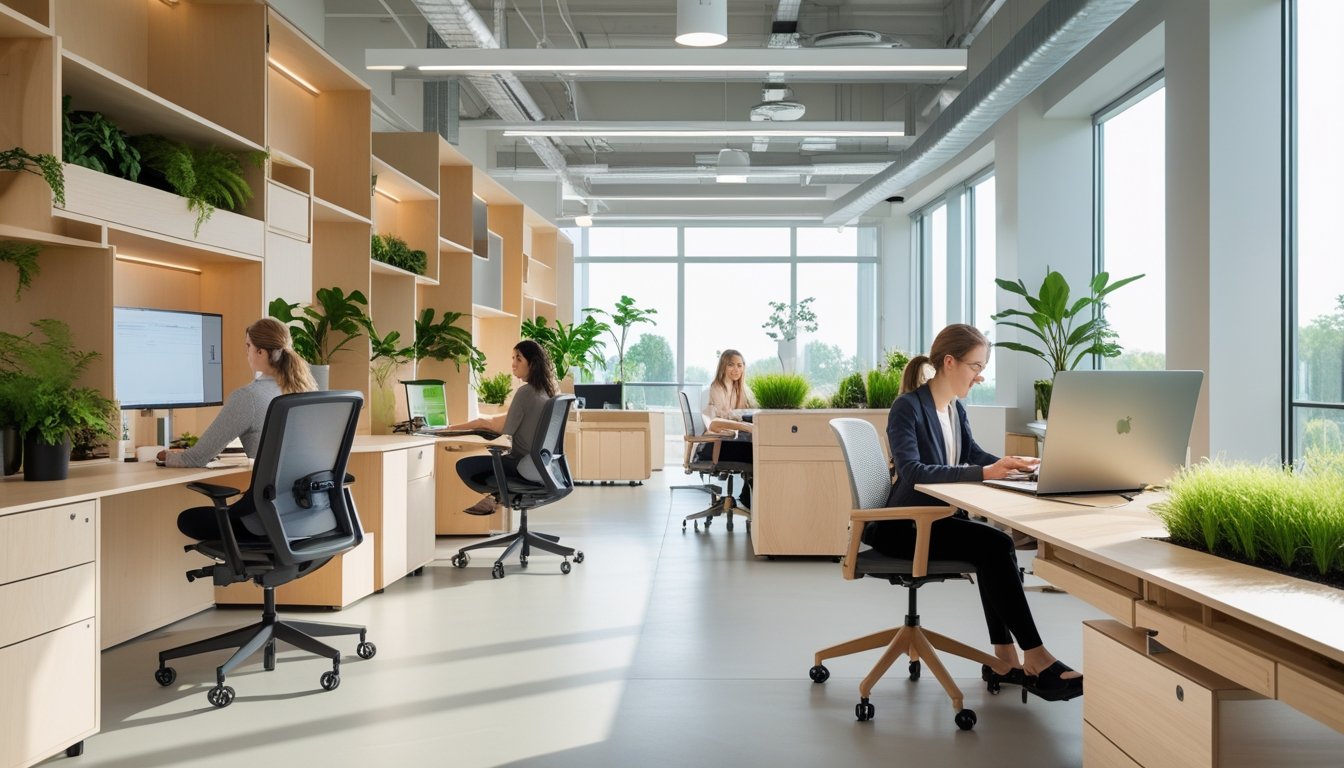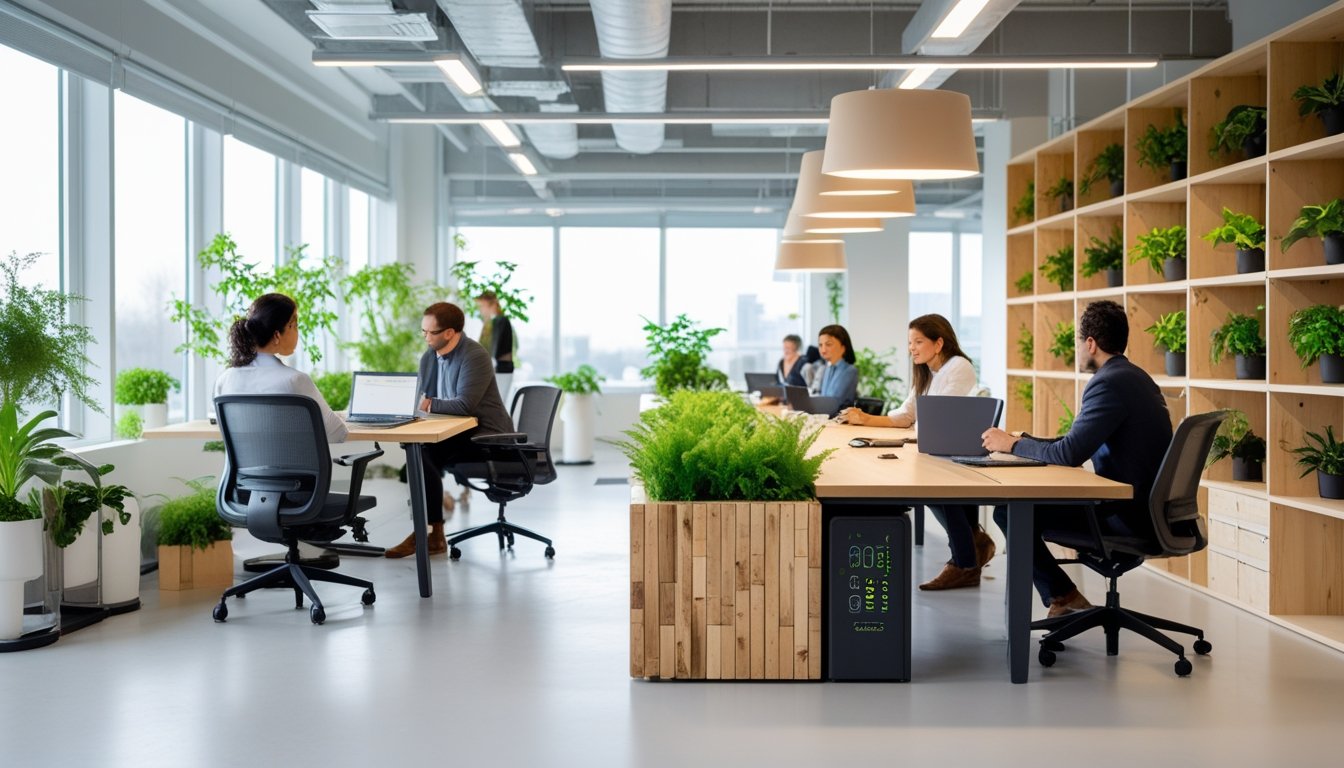Late updated: 03 Aug 2025 13:08
Written by: Amber Collins
Innovative Sustainable Office Furniture Trends: Leading the Future of Workspace Design
Sustainable office furniture is taking centre stage as we explore new ways to create environmentally friendly and stylish workspaces. The trend is rapidly moving towards using materials like reclaimed wood, recycled plastics, and low-VOC finishes to craft office furniture that not only looks great but also minimises our carbon footprint. This commitment to innovative design allows businesses to maintain high standards of functionality and aesthetics without compromising on sustainability.

As we progress, it’s fascinating to see companies prioritise wellness and versatility in their office layouts. Incorporating biophilic elements and smart technology into office designs ensures we create healthier and more efficient work environments. By harnessing the potential of sustainable materials, we're able to offer versatile solutions that appeal to a wide range of design preferences.
With the commercial furniture industry on the brink of major transformations, there is a compelling mix of creativity and functionality driving these innovations. This movement not only revolutionises how we perceive office furniture but also sets a new standard for future-ready workspaces that are both eco-friendly and adaptive to the needs of today's workforce.
Key Takeaways
- Sustainable materials are central to innovative office furniture trends.
- Biophilic design and smart technology enhance workspace efficiency.
- Future-ready workspaces focus on eco-friendliness and adaptability.
Key Trends in Innovative Sustainable Office Furniture
In recent years, the demand for sustainable office furniture has gained significant momentum. These innovative trends focus on eco-friendly materials, ergonomic designs, and the integration of advanced technology to create optimal workspaces. Our exploration uncovers the major advancements shaping the future of workplace design.
Eco-Friendly Materials and Sustainability
Sustainability is at the forefront of modern office furniture design. Many manufacturers are shifting towards recycled plastics, sustainable woods, and other eco-friendly materials. This shift not only reduces environmental impact but also creates a positive corporate image. We are seeing a rise in bamboo and reclaimed wood being used to craft elegant office solutions that align with eco-friendly practices.
Innovative companies are also developing furniture that can be fully recycled at the end of its lifecycle. This commitment to sustainability helps decrease waste and promotes a circular economy. Additionally, the use of non-toxic finishes and low-VOC adhesives contributes to healthier indoor air quality, offering benefits beyond environmental conservation.
Ergonomics and Employee Well-Being
Ergonomic designs play a pivotal role in employee well-being and productivity. Our office environments must adapt to meet these needs effectively. Ergonomic chairs with adjustable features and adjustable desks allow employees to personalise their workspaces. This adaptability helps reduce the risk of posture-related issues and increases comfort during long working hours.
Beyond furniture adjustments, the focus on employee health extends to creating an inviting atmosphere with improved lighting and quieter environments. As we've observed, integrating natural elements like plants and natural lighting can boost morale and productivity. These designs support overall wellness by fostering both physical and mental health at work.
Smart Technology Integration
With the rapid advancement of technology, office furniture is becoming smarter and more efficient. Integrated systems such as smart desks allow users to track their posture and activity levels throughout the day. These pieces can connect to mobile apps, ensuring a more integrated and adaptable workspace experience.
Other innovations include desks with built-in wireless charging capabilities and data collection sensors that help personalise comfort for individual users. Our focus on networking technology means office furniture can now facilitate better communication and connectivity, improving collaboration across teams. The aim is smarter, more efficient use of time and space in our offices.
Modular and Flexible Office Furniture
The rise of modular and flexible office furniture solutions reflects the trend towards hybrid work models. These designs provide adaptability—we can easily reconfigure spaces based on needs, fostering a dynamic environment. This flexibility means offices can quickly adjust layouts without the necessity of new purchases.
Modular furniture often includes components that fit together in various configurations, offering versatility for different tasks and settings. The use of flexible workspaces encourages collaboration while also accommodating solitary tasks. By investing in modular solutions, businesses can maximise space utility and support a diverse range of activities within the workplace.
Design Strategies for Future-Ready Workspaces

Designing workspaces for the future requires a keen focus on adaptability, collaboration, and a connection to nature. These elements are crucial in catering to hybrid work models and enhancing employee engagement.
Adaptable Solutions for Hybrid Work
The hybrid work model demands flexibility in office design, accommodating both in-person and remote personnel. Modular furniture, which can be easily reconfigured to support different work modes, is a vital component. Adjustable desks and multi-functional spaces help staff transition between individual and group tasks effortlessly.
Smart technology, such as sensors and hot-desking solutions, also aids in managing space efficiently. They provide data-driven insights into space usage, enabling quick adaptations. This ensures workspaces remain responsive to the dynamic needs of a hybrid workforce.
Collaborative Spaces and Employee Engagement
Creating collaborative spaces is essential to foster innovation and strengthen team connections. Open-plan areas with moveable partitions allow teams to configure spaces that best suit their needs.
Incorporating technology, such as interactive screens and wireless connectivity, further enhances collaboration. However, quieter zones should also be available for focused work, maintaining a balance.
Employee engagement thrives when they have a say in their environment. Allowing staff to personalise their spaces, both individually and collectively, enhances job satisfaction and well-being.
Biophilic Design in Contemporary Offices
Biophilic design introduces natural elements into office settings, promoting well-being and productivity. Incorporating plant life and natural light plays a pivotal role. Green walls, potted plants, and large windows create a serene atmosphere that connects employees to nature.
Materials such as wood and stone further this connection, making interiors feel organic. Nature-inspired colours and patterns can subtly enhance the aesthetic appeal of the workplace.
Biophilic designs not only benefit individual health but also foster a sense of community. Implementing these elements in communal areas and collaborative spaces ensures a balanced and harmonious work environment, conducive to both social interactions and productive endeavours.
Frequently Asked Questions

As we explore the impact of sustainability in office furniture design, it's vital to look into design trends, material choices, certifications, and their overall effects on the workplace and cost. Let's address these important aspects to empower decisions towards a greener working environment.
What are the leading trends in eco-friendly office furniture design?
Current trends focus on using sustainable materials like reclaimed wood and recycled fabric. Organic shapes and multifunctional designs are also becoming popular as they combine eco-consciousness with modern aesthetics and functionality, making them a favourite choice for innovative office spaces.
How can office furniture contribute to a sustainable working environment?
Sustainable office furniture minimises waste and reduces carbon footprint through efficient use of resources. It often incorporates design elements that enhance air quality and maximise natural light, resulting in a healthier workspace. By promoting employee well-being, it also aids in boosting productivity and satisfaction.
What materials are commonly used in manufacturing sustainable office furniture?
Common materials include bamboo, recycled metals, and sustainably sourced wood. These materials are chosen for their renewability and minimal environmental impact. Additionally, some manufacturers are experimenting with biodegradable materials and innovative composites to further push the boundaries of eco-friendly design.
Are there certifications to look out for when choosing green office furnishings?
Yes, certifications like GREENGUARD and Forest Stewardship Council (FSC) labels verify products that meet specific sustainability standards. These certifications ensure that the furniture contributes to healthier indoor air quality and uses materials that are responsibly sourced, providing peace of mind for eco-conscious consumers.
How does sustainably produced office furniture impact workplace well-being?
Sustainably produced furniture often integrates biophilic design elements, such as natural materials and greenery, which are known to reduce stress and enhance mood. A well-designed sustainable environment can foster creativity, collaboration, and engagement among employees, driving a positive workplace culture.
What are the cost implications of investing in environmentally conscious office interiors?
While initially, sustainable furniture can be more expensive, the long-term benefits often outweigh the upfront costs. Eco-friendly furnishings are usually more durable and come with energy-saving features, which can result in reduced maintenance and utility costs over time. Investing in quality, sustainable options supports both financial and environmental sustainability.
